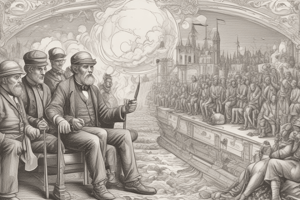Podcast
Questions and Answers
What were some of the negative effects of alcohol abuse mentioned in the text?
What were some of the negative effects of alcohol abuse mentioned in the text?
- Health problems, economic costs, social problems (correct)
- Health benefits, economic losses, social benefits
- Economic costs, educational issues, social challenges
- Mental health problems, legal issues, economic gains
When did the National Prohibition in the United States come to an end?
When did the National Prohibition in the United States come to an end?
- 1919
- 1940
- 1933 (correct)
- 1925
What was the impact of National Prohibition on society?
What was the impact of National Prohibition on society?
- Development of new policies, reduction in alcohol-related violence, decrease in organized crime
- Decrease in crime rates, increase in alcohol consumption, rise of black market
- Increase in government revenue, reduction in health issues, decrease in alcohol production
- Rise of organized crime, growth of black market, development of new alcohol forms (correct)
What were some of the key aspects of drug legislation history in the United States?
What were some of the key aspects of drug legislation history in the United States?
What was a focus of the War on Drugs launched in the 1980s?
What was a focus of the War on Drugs launched in the 1980s?
Flashcards are hidden until you start studying
Study Notes
History of Drug Use and Drug Legislation: Alcohol and the Temperance Movement, National Prohibition
Temperance Movement
The temperance movement began in the United States in the early 19th century as a response to the negative effects of alcohol abuse on individuals and society. The movement aimed to reduce the consumption of alcohol and eventually eliminate its use. The temperance movement was driven by religious beliefs, social concerns, and the desire to improve public health. Some key aspects of the temperance movement include:
-
Prohibition advocacy: The temperance movement advocated for the prohibition of alcohol, which eventually led to the passage of the 18th Amendment to the United States Constitution.
-
Temperance societies: Various temperance societies were formed, including the Women's Christian Temperance Union (WCTU), which played a significant role in promoting abstinence and advocating for laws restricting the sale and consumption of alcohol.
-
Alternatives to alcohol: The temperance movement also promoted the use of alternatives to alcohol, such as "near beer" and other low-alcohol or non-alcoholic beverages.
Effects of Alcohol Abuse
Alcohol abuse has a profound impact on individuals, families, and society as a whole. Some of the negative effects of alcohol abuse include:
-
Health problems: Alcohol abuse can lead to a range of health problems, including liver disease, cardiovascular disease, and mental health issues.
-
Economic costs: The economic costs of alcohol abuse are significant, including lost productivity, healthcare costs, and criminal justice costs.
-
Social problems: Alcohol abuse can contribute to social problems, such as domestic violence, child abuse, and other forms of interpersonal violence.
National Prohibition
In 1919, the 18th Amendment to the United States Constitution was ratified, effectively banning the production, sale, and consumption of alcohol. This was known as National Prohibition and lasted until 1933 when the 21st Amendment was ratified, repealing the 18th Amendment. Some key aspects of National Prohibition include:
-
Enforcement challenges: National Prohibition was difficult to enforce, leading to a thriving black market for alcohol and organized crime related to the production and distribution of illegal alcohol.
-
Impact on society: National Prohibition had a significant impact on society, including the rise of organized crime, the growth of the black market, and the development of new forms of alcohol.
-
Repeal: The repeal of National Prohibition was driven by a growing recognition of the negative consequences of the policy and the desire to return to a more normal regulatory system.
Drug Legislation History
The history of drug legislation in the United States has been marked by a series of laws and policies aimed at controlling the production, sale, and consumption of drugs. Some key aspects of drug legislation history include:
-
Harrison Narcotics Tax Act: In 1914, the Harrison Narcotics Tax Act was passed, which aimed to regulate the production, sale, and distribution of opiates and cocaine.
-
Marijuana Tax Act: In 1937, the Marijuana Tax Act was passed, which effectively prohibited the possession and use of marijuana.
-
Controlled Substances Act: In 1970, the Controlled Substances Act was passed, which established a system for classifying drugs based on their potential for abuse and dependence.
Anti-Drug Movements
Various anti-drug movements have emerged throughout history, driven by concerns about the negative effects of drug use on individuals and society. Some key aspects of anti-drug movements include:
-
War on Drugs: The War on Drugs was launched in the 1980s as a response to the perceived threat of drug use and trafficking, focusing on law enforcement and punishment.
-
Drug education: Many anti-drug movements have focused on drug education, aiming to raise awareness about the negative consequences of drug use and to promote prevention strategies.
-
Treatment and recovery: Some anti-drug movements have emphasized the importance of treating drug addiction as a medical condition and promoting recovery through supportive services and community-based programs.
Studying That Suits You
Use AI to generate personalized quizzes and flashcards to suit your learning preferences.




